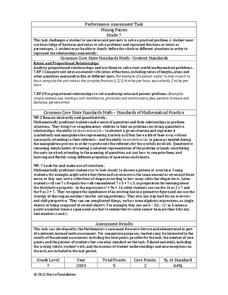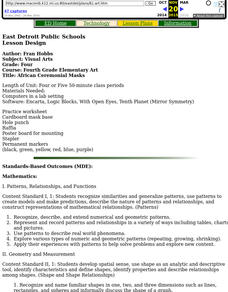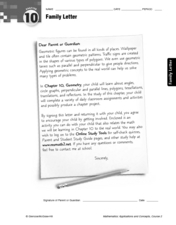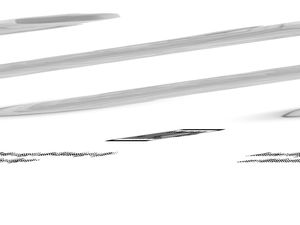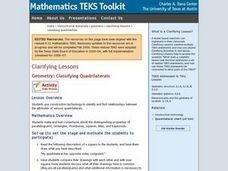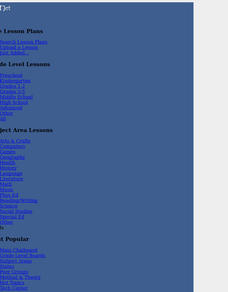Noyce Foundation
Granny’s Balloon Trip
Take flight with a fun activity focused on graphing data on a coordinate plane. As learners study the data for Granny's hot-air balloon trip, including the time of day and the distance of the balloon from the ground, they practice...
EngageNY
Multiplying and Factoring Polynomial Expressions (part 1)
Polynomial multiplication and factoring go hand in hand. Why not teach them together. This resource begins with an area model for distributing a monomial and then connects the process to factoring the GCF. Learners then advance to...
Inside Mathematics
Graphs (2006)
When told to describe a line, do your pupils list its color, length, and which side is high or low? Use a worksheet that engages scholars to properly label line graphs. It then requests two applied reasoning answers.
Noyce Foundation
Mixing Paints
Let's paint the town equal parts yellow and violet, or simply brown. Pupils calculate the amount of blue and red paint needed to make six quarts of brown paint. Individuals then explain how they determined the percentage of the brown...
Inside Mathematics
Snakes
Get a line on the snakes. The assessment task requires the class to determine the species of unknown snakes based upon collected data. Individuals analyze two scatter plots and determine the most likely species for five additional data...
Inside Mathematics
Two Solutions
Many problems in life have more than one possible solution, and the same is true for advanced mathematics. Scholars solve seven problems that all have at least two solutions. Then three higher-level thinking questions challenge them to...
Noyce Foundation
Boxes
Teach your class to think outside the box. Scholars use the concept of equality to solve a problem in the assessment task. They determine how to use a scale to identify the one box out of a set of nine boxes that is heavier than the others.
EngageNY
Graphing Cubic, Square Root, and Cube Root Functions
Is there a relationship between powers and roots? Here is a activity that asks individuals to examine the graphical relationship. Pupils create a table of values and then graph a square root and quadratic equation. They repeat the...
Inside Mathematics
Population
Population density, it is not all that it is plotted to be. Pupils analyze a scatter plot of population versus area for some of the states in the US. The class members respond to eight questions about the graph, specific points and...
Code.org
Canvas and Arrays in Apps
Scholars learn how to make a digital canvas and fill it with artwork by creating a drawing app using the canvas element. The activity requires learners to previous knowledge of arrays and return commands to draw images.
NOAA
To Explore Strange New Worlds
It's time to boldly go where your class has not gone before! The introductory lesson in a five-part series takes young oceanographers aboard the NOAA Ship Okeanos to begin a study of ocean exploration. The lesson includes a comparison of...
West Contra Costa Unified School District
Arithmetic Series
Fall for a series. Learners determine how to find out how far a skydiver falls in the first 20 seconds. The Algebra II lesson introduces the idea of adding up the terms of an arithmetic sequence. Pupils learn how to use Sigma notation to...
Curated OER
The Geometry of Indigenous Art
Learners examine the concepts of symmetry, rotations, reflections, translation, dialations, and tessellations and apply them to indigenous art. They also do Internet research and create artwork (painting, pottery, computer graphic design).
Curated OER
African Ceremonial Masks
Fourth graders examine and discuss the purposes and traditions of African ceremonial masks. They design and create African ceremonial masks using various materials.
Curated OER
Family Activity: Triangles and Quadrilaterals
In this triangles and quadrilaterals worksheet, students solve 7 short answer problems. Kids find objects around the house that are constructed from triangles, parallelograms, trapezoids, squares, rectangles. Students sketch the object...
Curated OER
Incorporate Black History into Math
February is Black History Month. So why not highlight lessons that connect mathematics to Africans and African Americans?
Curated OER
Textured Pottery using Self-Hardening Clay and Multicultural Design
Students create textured pottery. In this multicultural arts lesson, students follow step-by-step directions to create textured pottery with a multicultural design out of self-hardening clay.
Curated OER
Lines of Symmetry
Fifth graders explore the concept of symmetry using lines drawn through different shapes. The worksheet that is included in the lesson should be used to chart the lines of symmetry for the different shapes drawn.
Curated OER
Shh...It's a Secret!
Students explore codes, decode secret messages, and create codes of their own to use with their friends. They examine the use of gestures, letters, symbols and numbers in codes.
Curated OER
Multicultural Math Project
Sixth graders examine where mathematics came from. In this Math History lesson, 6th graders complete various activities to understand mathematical reasoning. Students complete critical thinking questions.
Curated OER
Kente Cloths
Second graders create examples of Kente cloths using paper, markers, and paints in this multi-cultural Art lesson for the second grade. The two part lesson includes an introduction of Kente Cloth designs and can be accomplished in one day.
Curated OER
Geometry: Classifying Quadrilaterals
Students use construction technology to identify and find relationships between the attributes of various quadrilaterals. They make and test conjectures about the distinguishing properties of parallelograms, rectangles, rhombuses,...
Curated OER
Lesson Exchange: Polygons (Middle, Mathematics)
Students discover the relationship between the sides of a polygon and the number of diagonals that can be drawn from one vertex, the number of triangles that those diagonals form, and the sum of the interior angles of that polygon.
Curated OER
Telling Time to 5 Minutes
Learners take part in various activities ranging from creating a human clock, to small group problem solving to reinforce the concept of telling time accurately to five minutes on an analog clock.
Other popular searches
- Extending Geometric Patterns
- Geometric Patterns 3rd Grade
- Geometric Patterns in Math
- Geometric Patterns Rules
- Rules for Geometric Patterns
- Simple Geometric Patterns
- Math Patterns Geometric Shapes
- Geometric Patterns Handouts
- Template Geometric Patterns
- Geometric Patterns Worksheet
- Numeric and Geometric Patterns
- Number and Geometric Patterns





